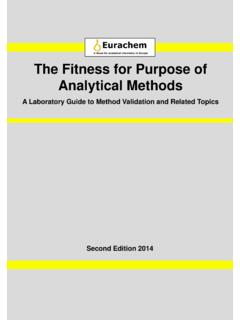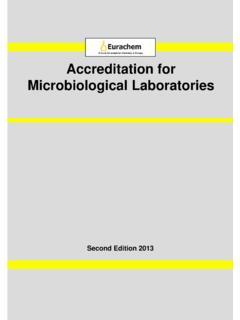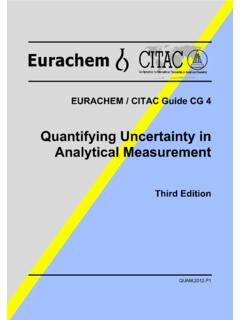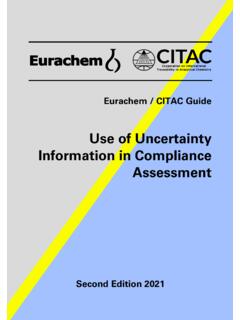Transcription of Guide to Quality in Analytical Chemistry - Eurachem
1 Eurachem / CITAC Guide Guide to Quality in Analytical Chemistry An Aid to Accreditation Third Edition QAC 2016. Eurachem /CITAC Guide Guide to Quality in Analytical Chemistry An Aid to Accreditation Third edition Acknowledgements This document has been prepared by members of the Eurachem Education and Training Working Group and others co-opted for this task. Those who have contributed to this edition are listed below. The authors are grateful to those other individuals and organisations who have contributed comments, advice and assistance. The revision of this Guide was in part supported by the UK government Department for Business, Energy &. Industrial Strategy (BEIS). Editor Vicki Barwick LGC (UK). Task Group Fatma Ak ada TUBITAK Ulusal Metroloji Enstitusu (UME) (TR). Mine Bilsel TUBITAK Ulusal Metroloji Enstitusu (UME) (TR). Renata Borroni Department of Public Veterinary Health and Food Safety, Istituto Superiore di Sanit (IT).
2 Pedro Pablo Morillas Bravo Canal de Isabel II Gesti n (ES). Ales Fajgelj International Atomic Energy Agency (CITAC member). Martina Hedrich Federal Institute for Materials Research and Testing (BAM) (DE). Nineta Hrastelj EuCheMS. Perihan Yolc mero lu Uludag University (TR). Mariana Arce Osuna Centro Nacional de Metrolog a (CENAM) (MX) (CITAC member). Marina Patriarca Department of Public Veterinary Health and Food Safety, Istituto Superiore di Sanit (IT). Elizabeth Prichard Consultant (UK). Riin Rebane University of Tartu (EE). Lorens Sibbesen LAB Quality (DK). Kevser Topal TUBITAK Ulusal Metroloji Enstitusu (UME) (TR). Kyriacos Tsimillis Pancyprian Union of Chemists (CY). Isabelle Vercruysse Belab (BE). Alex Williams Consultant (UK). Recommended citation This publication should be cited* as: V. Barwick (Ed), Eurachem /CITAC Guide : Guide to Quality in Analytical Chemistry : An Aid to Accreditation (3rd ed.)
3 2016). ISBN 978-0-948926-32-7. Available from . *Subject to journal requirements Guide to Quality in Analytical Chemistry : An Aid to Accreditation English edition Third edition 2016. ISBN 978-0-948926-32-7. Copyright 2016. Copyright in this document is held by the contributing authors. All enquiries regarding reproduction in any medium, including translation, should be directed to the Eurachem secretariat. Quality in Analytical Chemistry Eurachem /CITAC Guide Contents Foreword 1. Abbreviations and symbols 2. 1 Notes for the reader 4. 2 Introduction 5. 3 Definitions and terminology 7. 4 Accreditation 10. 5 Scope of accreditation 12. 6 The Analytical task 13. 7 Specification of Analytical requirement 14. 8 Analytical strategy 15. 9 Non-routine analysis 16. 10 Personnel 17. 11 Sampling, sample handling and preparation 19. 12 Environment 23. 13 Equipment 24. 14 Reagents and consumables 27.
4 15 Metrological traceability 28. 16 Measurement uncertainty 30. 17 Methods/procedures for calibrations and tests 32. 18 Method validation 33. 19 Calibration 36. 20 Reference materials 38. 21 Quality control and proficiency testing 40. 22 Computers and computer controlled systems 42. 23 Laboratory audit and review 45. Appendix A Quality audit: Areas of particular importance to a Chemistry laboratory 46. Appendix B Instrument calibration and performance checks 51. Bibliography 55. QAC 2016 Page i Quality in Analytical Chemistry Eurachem /CITAC Guide Foreword This edition is a revision of the CITAC/ Eurachem Guide published in 2002. The 2002 edition was developed from CITAC Guide 1 (which in turn was based on the Eurachem /WELAC Guide ). This revision reflects changes that were introduced with the publication of the 2005 version of ISO/IEC 17025 . The terminology has also been updated to take account of ISO/IEC 17000:2004, ISO 9000:2015 and the 3rd edition of the International Vocabulary of Metrology Basic and general concepts and associated terms (JCGM 200:2012 VIM).
5 The Guide focuses on the requirements of ISO/IEC 17025 , however the content should also be of use to organisations seeking accreditation or certification against the requirements of standards such as ISO 15189. or ISO 9001, or compliance with the Principles of Good Laboratory Practice. Similarly, although the Guide has the title Guide to Quality in Analytical Chemistry ' it is anticipated that it will also be of benefit to disciplines other than Chemistry . For those working in microbiology, it should be noted that Eurachem has published a Guide specifically for microbiological laboratories.. The Guide will also provide useful information both for laboratories that wish to establish a Quality management system but are not seeking formal recognition, and for those involved in education and training. The 2002 edition of the Guide contained an extensive reference and bibliography section.
6 For ease of management, the bibliography section in this edition contains only literature cited in the text. Additional documents related to accreditation and Quality assurance can be found in a reading list' under the menu item Publications' on the Eurachem website at . M. Eleftheriadou and K. C. Tsimillis (eds.), Eurachem Guide : Accreditation for microbiological laboratories (2nd ed. 2013), ISBN 978-91-87017-92-6. Available from QAC 2016 Page 1. Quality in Analytical Chemistry Eurachem /CITAC Guide Abbreviations and symbols The following abbreviations, acronyms and symbols appear in this Guide . AMC Analytical Methods Committee of the RSC. AOAC International a globally recognised standards developing organisation BIPM International Bureau of Weights and Measures CITAC Cooperation on International Traceability in Analytical Chemistry CLSI Clinical and Laboratory Standards Institute CRM certified reference material EA European cooperation for Accreditation EC European Commission EQA external Quality assessment EU European Union GLP Good Laboratory Practice GMP Good Manufacturing Practice GUM Evaluation of measurement data Guide to the expression of uncertainty in measurement HPLC high performance liquid chromatography IEC International Electrotechnical Commission ILAC International Laboratory Accreditation Cooperation ISO International Organization for Standardization IUPAC International Union of Pure and Applied Chemistry JCGM Joint Committee for Guides in Metrology k coverage factor (used in the)
7 Calculation of expanded uncertainty). LIMS laboratory information management system LOD limit of detection LOQ limit of quantification MLA Multilateral Agreement MRA Mutual Recognition Arrangement OECD Organisation for Economic Cooperation and Development OIML International Organization on Legal Metrology PCR polymerase chain reaction PVC poly vinyl chloride QA Quality assurance QC Quality control QMS Quality management system RSC Royal Society of Chemistry (UK). PT proficiency testing QAC 2016 Page 2. Quality in Analytical Chemistry Eurachem /CITAC Guide RM reference material s standard deviation SI international system of units SOP standard operating procedure u standard measurement uncertainty U expanded measurement uncertainty UV ultraviolet VCM vinyl chloride monomer VIM International vocabulary of metrology Basic and general concepts and associated terms WHO World Health Organization QAC 2016 Page 3.
8 Quality in Analytical Chemistry Eurachem /CITAC Guide 1 Notes for the reader Aims and objectives Terminology The aim of this Guide is to provide In the revision of this Guide one of the main laboratories with guidance on best practice for the areas of focus has been the updating of terminology Analytical operations they carry out. The guidance to reflect developments since the previous edition, covers both qualitative and quantitative analysis published in 2002. The Guide follows, where carried out on a routine or non-routine basis. A possible, the terminology defined in separate Guide covers research and development ISO/IEC 17000 [8], ISO 9000 [9] and the 3rd edition work [1]. of the VIM [10]. This has been supplemented, where necessary, with terminology used in The guidance is intended to help those ISO/IEC 17025 [2]. implementing a Quality management system (QMS). in a laboratory, in particular those seeking However, in some cases, it may be difficult to accreditation against the requirements of decide which term to use when several similar terms ISO/IEC 17025 [2].
9 For those working towards are in use. For clarity, it is considered important to accreditation it will help explain the meaning of the use a term consistently throughout the Guide . One standard. The guidance will also be useful to example is the term used to describe the document organisations seeking accreditation or certification that gives a detailed description of the method used against the requirements of standards such as in a laboratory. For quantitative analysis VIM refers ISO 15189 [3], ISO 15195 [4] or ISO 9001 [5], or to the measurement procedure, in ISO/IEC 17025 . compliance with the Principles of Good Laboratory this is referred to as the method, in ISO 15189 [3] it Practice (GLP) [6] or Good Manufacturing Practice is the examination procedure and many laboratories (GMP) [7], and to those involved in the assessment refer to their standard operating procedure (SOP).
10 In of Analytical laboratories against those line with other recent Eurachem guides the Task requirements. The Guide should also be of value to Group has decided to adhere to ISO/IEC 17025 and those involved in education and training. use the generic term method'. The term concentration' is used on its own ( unqualified). This Guide concentrates on the technical when a generality is required. In the Guide this term aspects of the Quality management of a laboratory, should be taken to represent a family of terms which with particular emphasis on those areas where includes mass fraction, mass concentration, amount interpretation is required for chemical testing or of substance concentration, etc. related measurements. The aspects of Quality management not covered in detail by this Guide (for The terms in VIM related to Analytical Chemistry are example contract review, records, reports and further explained in the Eurachem Guide complaints) are fully addressed in other documents, Terminology in Analytical measurement' [11].







